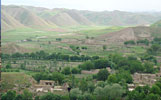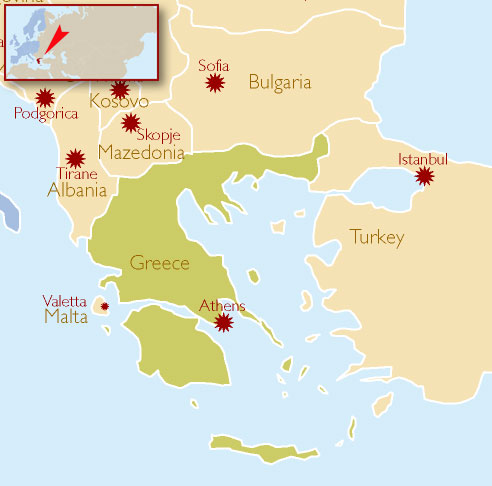Greece
The SpecialEasts on the road for you:
Western europe. Eastern europe. Balkans. Turkey. CIS. Middle East. Central Asia.

Zenit offers the following services for Greece:
You need to transport goods from or to Greece? Just give us a call.
Our team will find the right solution for you!
Greece - brief overview about the Zenit destination Greece.
Geopraphy

Greece consists of a mountainous, peninsular mainland jutting out into the sea at the southern end of the Balkans, the Peloponnesus peninsula (separated from the mainland by the canal of the Isthmus of Corinth), and numerous islands (1400, 227 of which are inhabited), including Crete, Euboea, Lesbos, Chios, the Dodecanese and the Cycladic groups of the Aegean Sea as well as the Ionian Sea islands. Greece has the tenth longest coastline in the world with 14,880 km (9,246 mi); its land boundary is 1,160 km (721 mi).
Eighty percent of Greece consists of mountains or hills, making the country one of the most mountainous in Europe. Mount Olympus, a focal point of Greek culture throughout history culminates at Mytikas peak 2,917 m (9,570 ft), the highest in the country. Once considered the throne of the Gods, it is today extremely popular among hikers and climbers. Western Greece contains a number of lakes and wetlands and is dominated by the Pindus mountain range. The Pindus reaches a maximum elevation of 2,637 m (8,652 ft) at Mt. Smolikas and is essentially a prolongation of the Dinaric Alps. The Vikos-Aoos Gorge is yet another spectacular formation and a popular hotspot for those fond of extreme sports.
The range continues through the central Peloponnese, crosses the islands of Kythera and Antikythera and find its way into southwestern Aegean, in the island of Crete where it eventually ends. The islands of the Aegean are peaks of underwater mountains that once constituted an extension of the mainland. Pindus is characterized by its high, steep peaks, often dissected by numerous canyons and a variety of other karstic landscapes. Most notably, the impressive Meteora formation consisting of high, steep boulders provides a breathtaking experience for the hundreds of thousands of tourists who visit the area each year.
Northeastern Greece features another high-altitude mountain range, the Rhodope range, spreading across the periphery of East Macedonia and Thrace; this area is covered with vast, thick, ancient forests. The famous Dadia forest is in the prefecture of Evros, in the far northeast of the country.
Expansive plains are primarily located in the prefectures of Thessaly, Central Macedonia and Thrace. They constitute key economic regions as they are among the few arable places in the country. Rare marine species such as the Pinniped Seals and the Loggerhead Sea Turtle live in the seas surrounding mainland Greece, while its dense forests are home to the endangered brown bear, the lynx, the Roe Deer and the Wild Goat.
Demographics

The official Statistical body of Greece is the National Statistical Service of Greece (NSSG). According to the NSSG, Greece's total population in 2001 was 10,964,020. That figure is divided into 5,427,682 males and 5,536,338 females. As statistics from 1971, 1981, and 2001 show, the Greek population has been aging the past several decades.
The birth rate in 2003 stood 9.5 per 1,000 inhabitants (14.5 per 1,000 in 1981). At the same time the mortality rate increased slightly from 8.9 per 1,000 inhabitants in 1981 to 9.6 per 1,000 inhabitants in 2003. In 2001, 16.71% of the population were 65 years old and older, 68.12% between the ages of 15 and 64 years old, and 15.18% were 14 years old and younger.
Greek society has also rapidly changed with the passage of time. Marriage rates kept falling from almost 71 per 1,000 inhabitants in 1981 until 2002, only to increase slightly in 2003 to 61 per 1,000 and then fall again to 51 in 2004. Divorce rates on the other hand, have seen an increase – from 191.2 per 1,000 marriages in 1991 to 239.5 per 1,000 marriages in 2004. Almost two-thirds of the Greek people live in urban areas. Greece's largest municipalities in 2001 were: Athens, Thessaloniki, Piraeus, Patras, Iraklio, Larissa, and Volos.
Throughout the 20th century, millions of Greeks migrated to the US, Australia, Canada, UK and Germany, creating a thriving Greek diaspora. The migration trend however has now been reversed after the important improvements of the Greek economy since the 80's.
Economy
Annual growth of Greek GDP has surpassed the respective levels of most of its EU partners. The tourism industry is a major source of foreign exchange earnings and revenue accounting for 15% of Greece’s total GDP and employing, directly or indirectly, 16.5% of the total workforce.
The Greek labor force totals 4.9 million, and it is the second most industrious between OECD countries, after South Korea. The Groningen Growth & Development Centre has published a poll revealing that between 1995 and 2005, Greece was the country with the largest work/hour ratio among European nations; Greeks worked an average of 1,900 hours per year, followed by the Spanish (average of 1,800 hours/year). In 2007, the average worker made around 20 dollars, similar to Spain and slightly more than half of average U.S. hourly income. Immigrants make up nearly one-fifth of the work force, occupied mainly in agricultural and construction work.
Greece's purchasing power-adjusted GDP per capita is the world's 26th highest. According to the International Monetary Fund it has an estimated average per capita income of $30,661 for the year 2008, a figure comparable to that of Germany, France or Italy. According to Eurostat data, Greek PPS GDP per capita stood at 95 per cent of the EU average in 2008. Greece ranks 18th in the 2006 HDI, 22nd on The Economist's 2005 worldwide quality-of-life index. According to a survey by the Economist, the cost of living in Athens is close to 90% of the costs in New York; in rural regions it is lower.
Climate
The climate of Greece is primarily Mediterranean, featuring mild, wet winters and hot, dry summers. This climate occurs at all coastal locations, including Athens, the Cyclades, the Dodecanese, Crete, the Peloponnese, the Ionian Islands and parts of the Central Continental Greece region. The Pindus mountain range strongly affects the climate of the country, as areas to the west of the range are considerably wetter on average (due to greater exposure to south-westerly systems bringing in moisture) than the areas lying to the east of the range (due to a rain shadow effect).
The mountainous areas of Northwestern Greece (parts of Epirus, Central Greece, Thessaly, Western Macedonia) as well as in the mountainous central parts of Peloponnese – including parts of the regional units of Achaea, Arcadia and Laconia – feature an Alpine climate with heavy snowfalls. The inland parts of northern Greece, in Central Macedonia and East Macedonia and Thrace feature a temperate climate with cold, damp winters and hot, dry summers with frequent thunderstorms. Snowfalls occur every year in the mountains and northern areas, and brief snowfalls are not unknown even in low-lying southern areas, such as Athens.
Infrastructure

Since the 1980s, the roads and rail network of Greece has been significantly modernised. Important works include the Egnatia highway that connects north west Greece (Igoumenitsa) with northern and north west Greece. The Rio-Antirio bridge (the longest suspension cable bridge in Europe) (2250 m or 7382 ft long) connects the western Peloponnesus from Rio (7 km or 4 mi from Patras) with Antirion on the central Greek mainland. An expansion of the Patras-Athens national motorway towards Pyrgos in the western Peloponnese is scheduled to be completed by 2014. Most of the highway connection of Athens to Thessaloniki has also been upgraded.
The metropolitan area of the capital Athens had a new international airport (opened in 2001), a new privately run suburban motorway Attiki Odos (opened 2001), and an expanded metro system (since 2000).
Most of the Greek islands and many main cities of Greece are connecting by air mainly from the two major airlines of Greece, Olympic and Aegean air. Maritime connections have been improved with modern high-speed craft, including hydrofoils and catamarans. Railway connections play a somewhat lesser role than in many other European countries, but railways too have been expanded, with new suburban connections around Athens, a modern intercity connection between Athens and Thessaloniki, and upgrading to double lines in many parts of the 2500 km (1550 mi) network. International railway lines connect Greek cities with the rest of Europe, the Balkans and Turkey.
More Information: http://en.wikipedia.org/wiki/Greece
Text is available under the Creative Commons Attribution-ShareAlike License; additional terms may apply. See Terms of Use for details.
Wikipedia® is a registered trademark of the Wikimedia Foundation, Inc., a non-profit organization.

 Deutsch
Deutsch Turkce
Turkce Russian
Russian